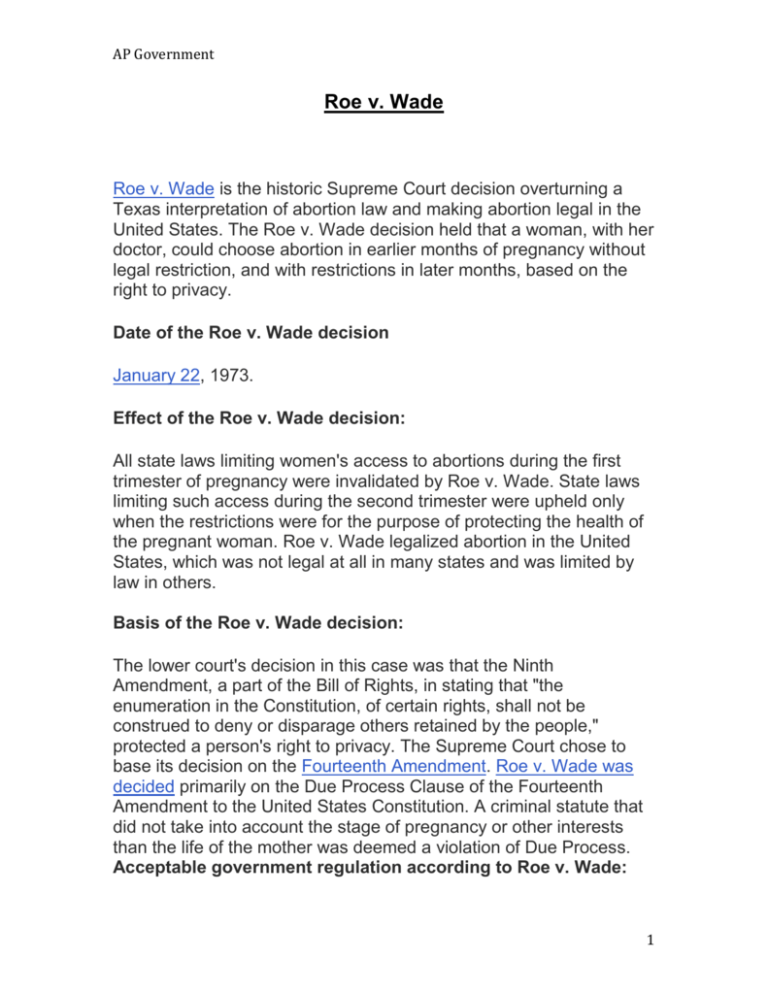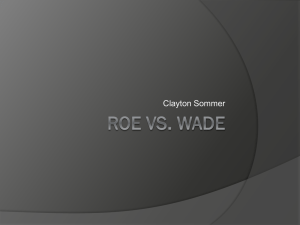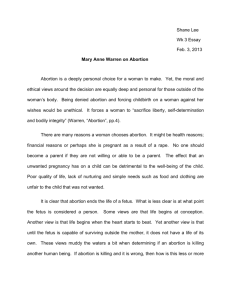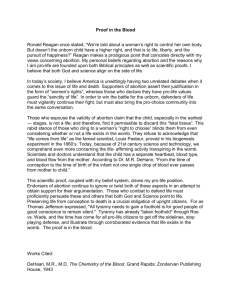
AP Government
Roe v. Wade
Roe v. Wade is the historic Supreme Court decision overturning a
Texas interpretation of abortion law and making abortion legal in the
United States. The Roe v. Wade decision held that a woman, with her
doctor, could choose abortion in earlier months of pregnancy without
legal restriction, and with restrictions in later months, based on the
right to privacy.
Date of the Roe v. Wade decision
January 22, 1973.
Effect of the Roe v. Wade decision:
All state laws limiting women's access to abortions during the first
trimester of pregnancy were invalidated by Roe v. Wade. State laws
limiting such access during the second trimester were upheld only
when the restrictions were for the purpose of protecting the health of
the pregnant woman. Roe v. Wade legalized abortion in the United
States, which was not legal at all in many states and was limited by
law in others.
Basis of the Roe v. Wade decision:
The lower court's decision in this case was that the Ninth
Amendment, a part of the Bill of Rights, in stating that "the
enumeration in the Constitution, of certain rights, shall not be
construed to deny or disparage others retained by the people,"
protected a person's right to privacy. The Supreme Court chose to
base its decision on the Fourteenth Amendment. Roe v. Wade was
decided primarily on the Due Process Clause of the Fourteenth
Amendment to the United States Constitution. A criminal statute that
did not take into account the stage of pregnancy or other interests
than the life of the mother was deemed a violation of Due Process.
Acceptable government regulation according to Roe v. Wade:
1
AP Government
Different rules at different stages of pregnancy were considered
appropriate:
• In the first trimester, the state (that is, any government) could treat
abortion only as a medical decision, leaving medical judgment
to the woman's physician.
• In the second trimester (before viability), the state's interest was
seen as legitimate when it was protecting the health of the
mother.
• After viability of the fetus (the likely ability of the fetus to be able to
survive outside and separated from the uterus), the potential of
human life could be considered as a legitimate state interest,
and the state could choose to "regulate, or even proscribe
abortion" as long as the life and health of the mother was
protected.
Who Roe and Wade were:
The alias "Jane Roe" was used for Norma McCorvey, on whose
behalf the suit was originally filed, alleging that the abortion law in
Texas violated her constitutional rights and the rights of other
women.. The defendant was the district attorney of Dallas County,
Texas, Henry B. Wade.
Who argued the case:
Sarah Weddington and Linda Coffee were the plaintiff's lawyers. John
Tolle, Jay Floyd and Robert Flowers were the defendant's lawyers.
Who voted for and against the Roe v. Wade decision:
The majority: Harry Blackmun, William J. Brennan, Chief Justice
Warren Burger, William O. Douglas, Thurgood Marshall, Lewis Powell
and Potter Stewart. The dissent: William Rehnquist and Byron White.
The majority opinion was written by Harry Blackmun. Concurring
opinions were written by Potter Stewart, Warren Burger, and William
O. Douglas. Dissenting opinions were written by William Rehnquist
and Byron White.
2
AP Government
Roe v. Wade
Brief Fact Summary. Appellant Jane Roe, a pregnant mother who
wished to obtain an abortion, sued on behalf of all woman similarly
situated in an effort to prevent the enforcement of Texas statutes
criminalizing all abortions except those performed to save the life of
the mother.
Synopsis of Rule of Law. Statutes that make criminal
all abortions except when medically advised for the purpose of saving
the life of the mother are an unconstitutional invasion of privacy.
Facts. Texas statutes made it a crime to procure or attempt an
abortion except when medically advised for the purpose of saving the
life of the mother. Appellant Jane Roe sought a declaratory judgment
that the statutes were unconstitutional on their face and an injunction
to prevent defendant Dallas County District Attorney from enforcing
the statutes. Appellant alleged that she was unmarried and pregnant,
and that she was unable to receive a legal abortion by a licensed
physician because her life was not threatened by the continuation of
her pregnancy and that she was unable to afford to travel to another
jurisdiction to obtain a legal abortion. Appellant sued on behalf of
herself and all other women similarly situated, claiming that the
statutes were unconstitutionally vague and abridged her right of
personal privacy, protected by the First, Fourth, Fifth, Ninth, and
Fourteenth Amendments.
Issue. Do the Texas statutes improperly
invade a right possessed by the appellant to terminate her pregnancy
embodied in the concept of personal liberty contained in the
Fourteenth Amendment’s Due Process Clause, in the personal
marital, familial, and sexual privacy protected by the Bill of Rights or
its penumbras, or among the rights reserved to the people by the
Ninth Amendment?
Held. The right to personal privacy includes the abortion decision, but
the right is not unqualified and must be considered against important
state interests in regulation.
The abortion laws in effect in the
majority of the States are of relatively recent vintage, deriving from
statutory changes generally enacted in the latter half of the 19th
century. At common law abortion performed before quickening (the
first recognizable movement of the fetus in utero) was not an
indictable offense, and it is doubtful that abortion was ever a firmly
3
AP Government
established common law crime even when it destroyed a quick fetus.
Three reasons have been advanced for the historical enactment of
criminal abortion laws. The first is that the laws are the product of a
Victorian social concern to discourage illicit sexual conduct, but this
argument has been taken seriously by neither courts nor
commentators. The second reason is that the abortion procedure is
hazardous, therefore the State’s concern is to protect pregnant
women. However, modern medical techniques have altered the
situation, with abortions being relatively safe particularly in the first
trimester. The third reason is the State’s interest is in protecting the
prenatal life. However, this is somewhat negated by the fact that the
pregnant woman cannot be prosecuted for the act of abortion.
For the stage prior to the approximate end of the first trimester, the
abortion decision must be left to the medical judgment of the
pregnant woman’s attending physician, and may not be criminalized
by statute.
For the stage subsequent to the approximate end of the first
trimester, the State may regulate abortion in ways reasonably related
to maternal health based upon the State’s interest in promoting the
health of the mother.
For the stage subsequent to viability, the State may regulate and
even proscribe abortion, except where necessary for the preservation
of the mother’s life, based upon the State’s interest in the potential of
the potential life of the unborn child.
Dissent. Justice Rehnquist. The right to an abortion is not universally
accepted, and the right to privacy is thus not inherently involved in
this case.
Discussion. The Court finds that an abortion statute that forbids all
abortions except in the case of a life saving procedure on behalf of
the mother is unconstitutional based upon the right to privacy.
However, it does allow for regulation and proscription of abortion
when the statute is narrowly tailored to uphold a compelling state
interest, such as the health of the mother or the viable fetus. The
court declined to address the question of when life begins.
4






